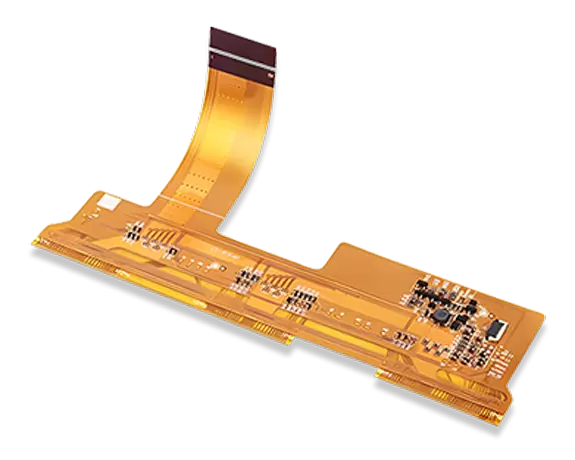 Ultra-thin, bendable and lightweight
Ultra-thin, bendable and lightweight
 Adapts to dynamic folding and curved installations
Adapts to dynamic folding and curved installations
 Eliminates the need for bulky connectors and cables in tight spaces
Eliminates the need for bulky connectors and cables in tight spaces
 Offers excellent heat dissipation and reliability under mechanical stress
Offers excellent heat dissipation and reliability under mechanical stress
 Used in automotive dashboards, rollable displays and flexible sensors
Used in automotive dashboards, rollable displays and flexible sensors

| Feature | Technical specification |
| Number of layers | 1-6 Layers |
| Materials | Polyimide, Polyester |
| Profile method | Laser cutting, punching, rout |
| Copper weights (finished) | 8 μm – 70 μm |
| FPC thickness | 0.05 mm – 0.80 mm |
| Max. dimensions | 250 mm x 610 mm |
| Min. track and gap | 0.05 mm / 0.05 mm |
| Min. mechanical drill | 0.1 mm |
| Surface finishes available | HASL (SnPb), LF HASL (SnNiCu), OSP, ENIG, Immersion Tin, Immersion Silver, Electrolytic gold, Gold fingers |
![]()
Engineering Support
![]()
Prototyping Services
![]()
Fast Turnaround
![]()
Seamless Transition to Mass Production
 What is the difference between flexible and rigid-flex PCBs?
What is the difference between flexible and rigid-flex PCBs?  What materials are used to make flexible PCBs?
What materials are used to make flexible PCBs?  What types of applications are suitable for flexible PCBs?
What types of applications are suitable for flexible PCBs?  What are the benefits of using flexible PCBs?
What are the benefits of using flexible PCBs?  What is a flexible PCB?
What is a flexible PCB?  What should I know before ordering flexible PCBs?
What should I know before ordering flexible PCBs? Good design is key. Clear bend areas, proper materials, and choosing a supplier with flex PCB experience help avoid cracks or breaks.

Customer support